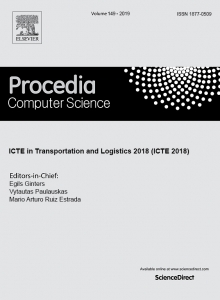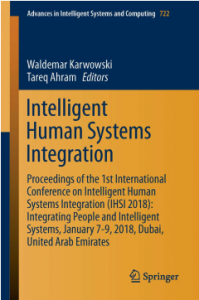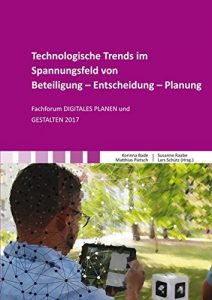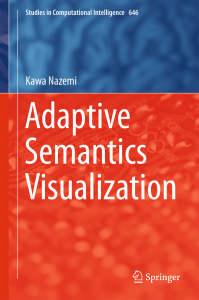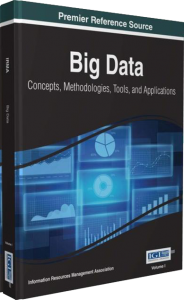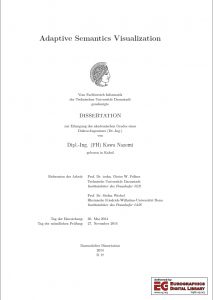Publikationen
Nazemi, Kawa; Burkhardt, Dirk In: Procedia Computer Science, Bd. 149, S. 138 - 150, 2019, ISSN: 1877-0509, (ICTE in Transportation and Logistics 2018 (ICTE 2018)). Abstract | Links | BibTeX | Schlagwörter: Information visualization Burkhardt, Dirk; Nazemi, Kawa In: Procedia Computer Science, Bd. 149, S. 515 - 524, 2019, ISSN: 1877-0509, (ICTE in Transportation and Logistics 2018 (ICTE 2018)). Abstract | Links | BibTeX | Schlagwörter: eGovernance, Information visualization, Law visualization, Mobility, Ontology visualization, Semantic visualization, Semantics visualization Nazemi, Kawa; Burkhardt, Dirk The 4th International Conference of the Virtual and Augmented Reality in Education, I3M I3M, 2018, ISBN: 978-88-85741-21-8. Abstract | Links | BibTeX | Schlagwörter: Information visualization, User-centered design, Visual analytics Burkhardt, Dirk; Nazemi, Kawa Visualizing Law - A Norm-Graph Visualization Approach based on Semantic Legal Data Konferenz The 4th International Conference of the Virtual and Augmented Reality in Education, I3M I3M, 2018, ISBN: 978-88-85741-21-8. Abstract | Links | BibTeX | Schlagwörter: Information visualization, Semantic visualization, Visual analytics Nazemi, Kawa Intelligent Visual Analytics -- a Human-Adaptive Approach for Complex and Analytical Tasks Buchkapitel In: Karwowski, W.; Ahram, T. (Hrsg.): Intelligent Human Systems Integration: Proceedings of the International Conference on Intelligent Human Systems Integration (IHSI 2018): Integrating People and Intelligent Systems. Advances in Intelligent Systems and Computing (AISC 722), S. 180–190, Springer International Publishing, Cham, 2018, ISBN: 978-3-319-73888-8. Abstract | Links | BibTeX | Schlagwörter: Adaptive visualization, Human Factors, Intelligent Systems Burkhardt, Dirk; Pattan, Sachin; Nazemi, Kawa; Kuijper, Arjan Search Intention Analysis for Task- and User-Centered Visualization in Big Data Applications Artikel In: Procedia Computer Science, Bd. 104, S. 539 - 547, 2017, ISSN: 1877-0509, (ICTE 2016, Riga Technical University, Latvia). Abstract | Links | BibTeX | Schlagwörter: Information visualization, Intelligent Systems, User behavior, User Interactions, User Interface, User-centered design, Visual analytics Burkhardt, Dirk; Nazemi, Kawa Informationsvisualisierung und Visual Analytics zur Unterstützung von E-Government Prozessen Proceedings Article In: Bade, Korinna; Pietsch, Matthias; Raabe, Susanne; Schütz, Lars (Hrsg.): Technologische Trends im Spannungsfeld von Beteiligung – Entscheidung – Planung, S. 29-38, Shaker Verlag, 2017, ISBN: 978-3844054392. Abstract | Links | BibTeX | Schlagwörter: eGovernance, Information visualization, Visual analytics Nazemi, Kawa; Burkhardt, Dirk; Kuijper, Arjan Analyzing the Information Search Behavior and Intentions in Visual Information Systems Artikel In: Journal of Computer Science Technology Updates, Bd. 4, 2017. Abstract | Links | BibTeX | Schlagwörter: Human Factors, Human-centered user interfaces, Human-computer interaction (HCI), Information visualization, User behavior, User Interactions, User Interface, User modeling, User-centered design, Visual analytics Nazemi, Kawa Adaptive Semantics Visualization Buch Springer International Publishing, Studies in Computational Intelligence 646, 2016, ISBN: 978-3-319-30815-9. Abstract | Links | BibTeX | Schlagwörter: Adaptive visualization, Human Factors, Information visualization, Intelligent Systems, Visual analytics Nazemi, Kawa; Steiger, Martin; Burkhardt, Dirk; Kohlhammer, Jörn Information Visualization and Policy Modeling Buchkapitel In: Big Data: Concepts, Methodologies, Tools, and Applications, Information Science Reference, IGI Global, Hershey PA, USA, 2016, ISBN: 978-1-466-69840-6, (reprint). Abstract | Links | BibTeX | Schlagwörter: Human-centered user interfaces, Information visualization, Semantic data modeling, Semantic visualization, User-centered design, Visual analytics Nazemi, Kawa; Retz, Reimond; Burkhardt, Dirk; Kuijper, Arjan; Kohlhammer, Jörn; Fellner, Dieter W Visual Trend Analysis with Digital Libraries Proceedings Article In: Proceedings of the 15th International Conference on Knowledge Technologies and Data-driven Business., S. 14:1–14:8, ACM, Graz, Austria, 2015, ISBN: 978-1-4503-3721-2. Abstract | Links | BibTeX | Schlagwörter: Data Analytics, datamining, Information extraction, Information visualization, Trend analysis, Visual analytics Burkhardt, Dirk; Nazemi, Kawa; Parisay, Mohsen; Kohlhammer, Jörn In: International Journal of Digital Society (IJDS), Bd. 5, Nr. 3, S. 915–923, 2015, ISSN: 2040-2570. Abstract | Links | BibTeX | Schlagwörter: Burkhardt, Dirk; Nazemi, Kawa; Kohlhammer, Jörn Policy Modeling Methodologies Buchkapitel In: Public Affairs and Administration: Concepts, Methodologies, Tools, and Applications, IGI Global, 2015, ISBN: 978-1-466-68358-7, (reprint). Abstract | Links | BibTeX | Schlagwörter: eGovernance, Policy modeling Nazemi, Kawa; Burkhardt, Dirk; Hoppe, David; Nazemi, Mariam; Kohlhammer, Jörn Web-based Evaluation of Information Visualization Artikel In: Procedia Manufacturing, Bd. 3, S. 5527 - 5534, 2015, ISSN: 2351-9789, (6th International Conference on Applied Human Factors and Ergonomics (AHFE 2015) and the Affiliated Conferences, AHFE 2015). Abstract | Links | BibTeX | Schlagwörter: Evaluation Methods, Evaluation Tools, Human Perception, Information visualization, User Study, User-centered design, Web-based Evaluation Burkhardt, Dirk; Nazemi, Kawa; Ginters, Egils; Aizstrauts, Artis; Kohlhammer, Jörn Explorative Visualization of Impact Analysis for Policy Modeling by Bonding Open Government and Simulation Data Proceedings Article In: Yamamoto, Sakae (Hrsg.): International Conference on Human Interface and the Management of Information (HIMI 2015). Information and Knowledge Design., S. 34–45, Springer International Publishing, Cham, 2015, ISBN: 978-3-319-20612-7. Abstract | Links | BibTeX | Schlagwörter: Exploration, Semantics visualization, Simulation, User behavior, User Interactions, User Interface, User-centered design, Visual analytics Sonntagbauer, Susanne; Sonntagbauer, Peter; Nazemi, Kawa; Burkhardt, Dirk The FUPOL Policy Lifecycle Buchkapitel In: Public Affairs and Administration: Concepts, Methodologies, Tools, and Applications., S. 158-186, Business Science Reference (IGI Global), Hershey PA, USA, Hershey PA, USA, 2015, ISBN: 978-1-466-68358-7, (reprint). Abstract | Links | BibTeX | Schlagwörter: eGovernance, Policy modeling Burkhardt, Dirk; Nazemi, Kawa; Zilke, Jan Ruben; Kohlhammer, Jörn; Kuijper, Arjan Fundamental Aspects for E-Government Buchkapitel In: Standards and Standardization: Concepts, Methodologies, Tools, and Applications, IGI Global, Hershey PA, USA, 2015, ISBN: 978-1-466-68111-8, (reprint). Abstract | Links | BibTeX | Schlagwörter: eGovernance, Policy modeling Burkhardt, Dirk; Nazemi, Kawa; Tomic, Silvana; Ginters, Egils Best-practice Piloting of Integrated Social Media Analysis Solution for E-Participation in Cities Artikel In: Procedia Computer Science, Bd. 77, S. 11 - 21, 2015, ISSN: 1877-0509, (ICTE in regional Development 2015 Valmiera, Latvia). Abstract | Links | BibTeX | Schlagwörter: Decision Making, E-Governmant, Evaluation, Information Communication Technologies, Piloting, Policy modeling Nazemi, Kawa; Burkhardt, Dirk; Ginters, Egils; Kohlhammer, Jorn Semantics Visualization – Definition, Approaches and Challenges Artikel In: Procedia Computer Science, Bd. 75, S. 75 - 83, 2015, ISSN: 1877-0509, (2015 International Conference Virtual and Augmented Reality in Education). Abstract | Links | BibTeX | Schlagwörter: Semantic visualization, Simulation, Visual analytics, Visualization and virtualization Nazemi, Kawa Adaptive Semantics Visualization Promotionsarbeit Technische Universität Darmstadt, 2014, (Reprint by Eugraphics Association (EG)). Abstract | Links | BibTeX | Schlagwörter: Adaptive information visualization, Adaptive user interfaces, Adaptive visualization, Computer based learning, Data Analytics, E-Learning, Exploratory learning, Human Factors, Human-centered user interfaces, Human-computer interaction (HCI), Information visualization, Intelligent Systems, Interaction analysis, Interaction Design, Ontology visualization, personalization, Policy modeling, reference model, Semantic data modeling, Semantic visualization, Semantic web, Semantics visualization, User behavior, User Interactions, User Interface, User modeling, User-centered design, Visual analytics2019
@article{Nazemi2019b,
title = {Visual analytical dashboards for comparative analytical tasks – a case study on mobility and transportation},
author = {Kawa Nazemi and Dirk Burkhardt},
url = {https://www.sciencedirect.com/science/article/pii/S1877050919301243
https://www.sciencedirect.com/science/article/pii/S1877050919301243/pdf?md5=2ab7848a8c215fa8998ada154e55b2c5&pid=1-s2.0-S1877050919301243-main.pdf, full text},
doi = {10.1016/j.procs.2019.01.117},
issn = {1877-0509},
year = {2019},
date = {2019-03-01},
journal = {Procedia Computer Science},
volume = {149},
pages = {138 - 150},
abstract = {Mobility, logistics and transportation are emerging fields of research and application. Humans’ mobility behavior plays an increasing role for societal challenges. Beside the societal challenges these areas are strongly related to technologies and innovations. Gathering information about emerging technologies plays an increasing role for the entire research in this ares. Humans’ information processing can be strongly supported by Visual Analytics that combines automatic modelling and interactive visualizations. The juxtapose orchestration of interactive visualization enables gathering more information in a shorter time. We propose in this paper an approach that goes beyond the established methods of dashboarding and enables visualizing different databases, data-sets and sub-sets of data with juxtaposed visual interfaces. Our approach should be seen as an expandable method. Our main contributions are an in-depth analysis of visual task models and an approach for juxtaposing visual layouts as visual dashboards to enable solving complex tasks. We illustrate our main outcome through a case study that investigates the area of mobility and illustrates how complex analytical tasks can be performed easily by combining different visual interfaces.},
note = {ICTE in Transportation and Logistics 2018 (ICTE 2018)},
keywords = {Information visualization},
pubstate = {published},
tppubtype = {article}
}
@article{Burkhardt2019b,
title = {Visual legal analytics – A visual approach to analyze law-conflicts of e-Services for e-Mobility and transportation domain},
author = {Dirk Burkhardt and Kawa Nazemi},
url = {https://www.sciencedirect.com/science/article/pii/S1877050919301784
https://www.sciencedirect.com/science/article/pii/S1877050919301784/pdf?md5=754eea9a3a7282f84c582efd6e7d0479&pid=1-s2.0-S1877050919301784-main.pdf, full text},
doi = {https://doi.org/10.1016/j.procs.2019.01.170},
issn = {1877-0509},
year = {2019},
date = {2019-01-01},
journal = {Procedia Computer Science},
volume = {149},
pages = {515 - 524},
abstract = {The impact of the electromobility has next to the automotive industry also an increasing impact on the transportation and logistics domain. In particular the today’s starting switches to electronic trucks/scooter lead to massive changes in the organization and planning in this field. Public funding or tax reduction for environment friendly solutions forces also the growth of new mobility and transportation services. However, the vast changes in this domain and the high number of innovations of new technologies and services leads also into a critical legal uncertainty. The clarification of a legal status for a new technology or service can become cost intensive in a dimension that in particular startups could not invest. In this paper we therefore introduce a new approach to identify and analyze legal conflicts based on a business model or plan against existing laws. The intention is that an early awareness of critical legal aspect could enable an early adoption of the planned service to ensure its legality. Our main contribution is distinguished in two parts. Firstly, a new Norm-graph visualization approach to show laws and legal aspects in an easier understandable manner. And secondly, a Visual Legal Analytics approach to analyze legal conflicts e.g. on the basis of a business plans. The Visual Legal Analytics approach aims to provide a visual analysis interface to validate the automatically identified legal conflicts resulting from the pre-processing stage with a graphical overview about the derivation down to the law roots and the option to check the original sources to get further details. At the end analyst can so verify conflicts as relevant and resolve it by advancing e.g. the business plan or as irrelevant. An evaluation performed with lawyers has proofed our approach.},
note = {ICTE in Transportation and Logistics 2018 (ICTE 2018)},
keywords = {eGovernance, Information visualization, Law visualization, Mobility, Ontology visualization, Semantic visualization, Semantics visualization},
pubstate = {published},
tppubtype = {article}
}
2018
@conference{Nazemi2018b,
title = {Juxtaposing Visual Layouts – An Approach for Solving Analytical and Exploratory Tasks through Arranging Visual Interfaces},
author = {Kawa Nazemi and Dirk Burkhardt},
editor = {A. G. Bruzzone and E. GINTERS and E. G. Mendívil and J. M. Guitierrez and F. Longo},
url = {https://www.scopus.com/record/display.uri?eid=2-s2.0-85056741373&origin=inward&txGid=9b80a3dc76c1623f440ddf04fde00bea, Scopus},
doi = {10.5281/zenodo.2542952},
isbn = {978-88-85741-21-8},
year = {2018},
date = {2018-09-18},
booktitle = {The 4th International Conference of the Virtual and Augmented Reality in Education},
publisher = {I3M},
organization = {I3M},
abstract = {Interactive visualization and visual analytics systems enables solving a variety of tasks. Starting with simple search tasks for outliers, anomalies etc. in data to analytical comparisons, information visualizations may lead to a faster and more precise solving of tasks. There exist a variety of methods to support users in the process of task solving, e.g. superimposing, juxtaposing or partitioning complex visual structures. Commonly all these methods make use of a single data source that is visualized at the same time. We propose in this paper an approach that goes beyond the established methods and enables visualizing different databases, data-sets and sub-sets of data with juxtaposed visual interfaces. Our approach should be seen as an expandable method. Our main contributions are an in-depth analysis of visual task models and an approach for juxtaposing visual layouts as visual interfaces to enable solving complex tasks.},
keywords = {Information visualization, User-centered design, Visual analytics},
pubstate = {published},
tppubtype = {conference}
}
@conference{Burkhardt2018,
title = {Visualizing Law - A Norm-Graph Visualization Approach based on Semantic Legal Data},
author = {Dirk Burkhardt and Kawa Nazemi},
editor = {A. G. Bruzzone and E. GINTERS and E. G. Mendívil and J. M. Guitierrez and F. Longo},
url = {https://www.scopus.com/record/display.uri?eid=2-s2.0-85056721291&origin=inward&txGid=497efbb2698c5dc7e8406ede09327453, Scopus},
isbn = {978-88-85741-21-8},
year = {2018},
date = {2018-09-17},
booktitle = {The 4th International Conference of the Virtual and Augmented Reality in Education},
publisher = {I3M},
organization = {I3M},
abstract = {Laws or in general legal documents regulate a wide range of our daily life and also define the borders of business models and commercial services. However, legal text and laws are almost hard to understand. From other domains it is already known that visualizations can help understanding complex aspects easier. In fact, in this paper we introduce a new approach to visualize legal texts in a Norm-graph visualization. In the developed Norm-graph visualization it is possible to show major aspects of laws and make it easier for users to understand it. The Norm-graph is based on semantic legal data, a so called Legal-Concept-Ontology.},
keywords = {Information visualization, Semantic visualization, Visual analytics},
pubstate = {published},
tppubtype = {conference}
}
@inbook{Nazemi2018,
title = {Intelligent Visual Analytics -- a Human-Adaptive Approach for Complex and Analytical Tasks},
author = {Kawa Nazemi},
editor = {W. Karwowski and T. Ahram},
url = {https://doi.org/10.1007/978-3-319-73888-8_29},
doi = {10.1007/978-3-319-73888-8_29},
isbn = {978-3-319-73888-8},
year = {2018},
date = {2018-01-01},
booktitle = {Intelligent Human Systems Integration: Proceedings of the International Conference on Intelligent Human Systems Integration (IHSI 2018): Integrating People and Intelligent Systems. Advances in Intelligent Systems and Computing (AISC 722)},
pages = {180--190},
publisher = {Springer International Publishing},
address = {Cham},
abstract = {Visual Analytics enables solving complex and analytical tasks by combining automated data analytics methods and interactive visualizations. The complexity of tasks, the huge amount of data and the complex visual representation may overstrain the users of such systems. Intelligent and adaptive visualizations system show already promising results to bridge the gap between human and the complex visualization. We introduce in this paper a revised version of layer-based visual adaptation model that considers the human perception and cognition abilities. The model is then used to enhance the most popular Visual Analytics model to enable the development of Intelligent Visual Analytics systems.},
keywords = {Adaptive visualization, Human Factors, Intelligent Systems},
pubstate = {published},
tppubtype = {inbook}
}
2017
@article{Burkhardt2017c,
title = {Search Intention Analysis for Task- and User-Centered Visualization in Big Data Applications},
author = {Dirk Burkhardt and Sachin Pattan and Kawa Nazemi and Arjan Kuijper},
url = {https://www.sciencedirect.com/science/article/pii/S1877050917301710, Elsevier Science Direct
https://www.sciencedirect.com/science/article/pii/S1877050917301710/pdf?md5=505e85e86e138c532368faf70d2ab1e2&pid=1-s2.0-S1877050917301710-main.pdf, full text},
doi = {https://doi.org/10.1016/j.procs.2017.01.170},
issn = {1877-0509},
year = {2017},
date = {2017-12-01},
journal = {Procedia Computer Science},
volume = {104},
pages = {539 - 547},
abstract = {A new approach for classifying users’ search intentions is described in this paper. The approach uses the parameters: word frequency, query length and entity matching for distinguishing the user's query into exploratory, targeted and analysis search. The approach focuses mainly on word frequency analysis, where different sources for word frequency data are considered such as the Wortschatz frequency service by the University of Leipzig and the Microsoft Ngram service (now part of the Microsoft Cognitive Services). The model is evaluated with the help of a survey tool and few machine learning techniques. The survey was conducted with more than one hundred users and on evaluating the model with the collected data, the results are satisfactory. In big data applications the search intention analysis can be used to identify the purpose of a performed search, to provide an optimal initially set of visualizations that respects the intended task of the user to work with the result data.},
note = {ICTE 2016, Riga Technical University, Latvia},
keywords = {Information visualization, Intelligent Systems, User behavior, User Interactions, User Interface, User-centered design, Visual analytics},
pubstate = {published},
tppubtype = {article}
}
@inproceedings{Burkhardt2017,
title = {Informationsvisualisierung und Visual Analytics zur Unterstützung von E-Government Prozessen},
author = {Dirk Burkhardt and Kawa Nazemi},
editor = {Korinna Bade and Matthias Pietsch and Susanne Raabe and Lars Schütz},
url = {https://www.shaker.de/de/content/catalogue/index.asp?lang=de&ID=8&ISBN=978-3-8440-5439-2&search=yes},
doi = {10.2370/9783844054392},
isbn = {978-3844054392},
year = {2017},
date = {2017-01-05},
booktitle = {Technologische Trends im Spannungsfeld von Beteiligung – Entscheidung – Planung},
pages = {29-38},
publisher = {Shaker Verlag},
abstract = {Politische und gesellschaftliche Prozesse werden durch Informationen sehr stark geprägt, wie auch die jüngsten Ereignisse aufzeigen. Diese Informationen können, trotz enormer Fortschritte, nicht immer aus den sehr großen, heterogenen und verteilten Daten entnommen werden. „Big Data“ stellt somit auch in der öffentlichen Verwaltung eine immer größere Herausforderung dar. Sowohl durch eine umfangreiche Erhebung von Statistiken, als auch durch Dokumente wie Berichte und Studien, wachsen in Behörden die zu bewältigenden Informationsaufgaben. Darüber hinaus spielt die Berücksichtigung von Bürgermeinungen, vor allem auf kommunaler Ebene, eine immer größere Rolle. Eine Auswertung ohne moderne Informationstechnik ist dabei kaum mehr möglich. Damit aber aus diesen Daten tatsächlich die relevanten Informationen extrahiert werden, bedarf es Informationsvisualisierung und Visual Analytics Systeme die sehr detaillierte, aber dennoch einfache und schnelle Analysen für den Menschen erlauben. Dies stellt aber sehr hohe Anforderungen an die visuellen Systeme, da sie gleichzeitig auch den Nutzer und dessen Fähigkeiten berücksichtigen müssen.},
keywords = {eGovernance, Information visualization, Visual analytics},
pubstate = {published},
tppubtype = {inproceedings}
}
@article{Nazemi2017,
title = {Analyzing the Information Search Behavior and Intentions in Visual Information Systems},
author = {Kawa Nazemi and Dirk Burkhardt and Arjan Kuijper},
url = {https://www.cosmosscholars.com/images/JCSTU/JCSTU-V4N2A2-Nazemi.pdf, full text},
doi = {10.15379/2410-2938.2017.04.02.02},
year = {2017},
date = {2017-01-01},
journal = {Journal of Computer Science Technology Updates},
volume = {4},
abstract = {Visual information search systems support different search approaches such as targeted, exploratory or analytical search. Those visual systems deal with the challenge of composing optimal initial result visualization sets that face the search intention and respond to the search behavior of users. The diversity of these kinds of search tasks require different sets of visual layouts and functionalities, e.g. to filter, thrill-down or even analyze concrete data properties. This paper describes a new approach to calculate the probability towards the three mentioned search intentions, derived from users’ behavior. The implementation is realized as a web-service, which is included in a visual environment that is designed to enable various search strategies based on heterogeneous data sources. In fact, based on an entered search query our developed search intention analysis web-service calculates the most probable search task, and our visualization system initially shows the optimal result set of visualizations to solve the task. The main contribution of this paper is a probability-based approach to derive the users’ search intentions based on the search behavior enhanced by the application to a visual system.},
keywords = {Human Factors, Human-centered user interfaces, Human-computer interaction (HCI), Information visualization, User behavior, User Interactions, User Interface, User modeling, User-centered design, Visual analytics},
pubstate = {published},
tppubtype = {article}
}
2016
@book{C35-P-25155,
title = {Adaptive Semantics Visualization},
author = {Kawa Nazemi},
url = {https://www.springer.com/de/book/9783319308159},
doi = {10.1007/978-3-319-30816-6},
isbn = {978-3-319-30815-9},
year = {2016},
date = {2016-12-01},
publisher = {Springer International Publishing, Studies in Computational Intelligence 646},
series = {Studies in Computational Intelligence 646},
abstract = {This book introduces a novel approach for intelligent visualizations that adapts the different visual variables and data processing to human's behavior and given tasks. Thereby a number of new algorithms and methods are introduced to satisfy the human need of information and knowledge and enable a usable and attractive way of information acquisition. Each method and algorithm is illustrated in a replicable way to enable the reproduction of the entire "SemaVis" system or parts of it. The introduced evaluation is scientifically well-designed and performed with more than enough participants to validate the benefits of the methods. Beside the introduced new approaches and algorithms, readers may find a sophisticated literature review in Information Visualization and Visual Analytics, Semantics and information extraction, and intelligent and adaptive systems. This book is based on an awarded and distinguished doctoral thesis in computer science.},
keywords = {Adaptive visualization, Human Factors, Information visualization, Intelligent Systems, Visual analytics},
pubstate = {published},
tppubtype = {book}
}
@inbook{Nazemi2016,
title = {Information Visualization and Policy Modeling},
author = {Kawa Nazemi and Martin Steiger and Dirk Burkhardt and Jörn Kohlhammer},
url = {https://www.igi-global.com/chapter/information-visualization-and-policy-modeling/150163, IGI Global},
doi = {10.4018/978-1-4666-9840-6.ch008},
isbn = {978-1-466-69840-6},
year = {2016},
date = {2016-01-01},
booktitle = {Big Data: Concepts, Methodologies, Tools, and Applications},
publisher = {Information Science Reference, IGI Global},
address = {Hershey PA, USA},
institution = {Information Resources Management Association USA},
organization = {Information Resources Management Association USA},
abstract = {Policy design requires the investigation of various data in several design steps for making the right decisions, validating, or monitoring the political environment. The increasing amount of data is challenging for the stakeholders in this domain. One promising way to access the “big data” is by abstracted visual patterns and pictures, as proposed by information visualization. This chapter introduces the main idea of information visualization in policy modeling. First abstracted steps of policy design are introduced that enable the identification of information visualization in the entire policy life-cycle. Thereafter, the foundations of information visualization are introduced based on an established reference model. The authors aim to amplify the incorporation of information visualization in the entire policy design process. Therefore, the aspects of data and human interaction are introduced, too. The foundation leads to description of a conceptual design for social data visualization, and the aspect of semantics plays an important role.},
note = {reprint},
keywords = {Human-centered user interfaces, Information visualization, Semantic data modeling, Semantic visualization, User-centered design, Visual analytics},
pubstate = {published},
tppubtype = {inbook}
}
2015
@inproceedings{Nazemi2015b,
title = {Visual Trend Analysis with Digital Libraries},
author = {Kawa Nazemi and Reimond Retz and Dirk Burkhardt and Arjan Kuijper and Jörn Kohlhammer and Dieter W Fellner},
url = {https://doi.acm.org/10.1145/2809563.2809569},
doi = {10.1145/2809563.2809569},
isbn = {978-1-4503-3721-2},
year = {2015},
date = {2015-10-01},
booktitle = {Proceedings of the 15th International Conference on Knowledge Technologies and Data-driven Business.},
pages = {14:1--14:8},
publisher = {ACM},
address = {Graz, Austria},
series = {i-KNOW '15},
abstract = {The early awareness of new technologies and upcoming trends is essential for making strategic decisions in enterprises and research. Trends may signal that technologies or related topics might be of great interest in the future or obsolete for future directions. The identification of such trends premises analytical skills that can be supported through trend mining and visual analytics. Thus the earliest trends or signals commonly appear in science, the investigation of digital libraries in this context is inevitable. However, digital libraries do not provide sufficient information for analyzing trends. It is necessary to integrate data, extract information from the integrated data and provide effective interactive visual analysis tools. We introduce in this paper a model that investigates all stages from data integration to interactive visualization for identifying trends and analyzing the market situation through our visual trend analysis environment. Our approach improves the visual analysis of trends by investigating the entire transformation steps from raw and structured data to visual representations.},
keywords = {Data Analytics, datamining, Information extraction, Information visualization, Trend analysis, Visual analytics},
pubstate = {published},
tppubtype = {inproceedings}
}
@article{Burkhardt2015eb,
title = {Visual Correlation Analysis to Explain Open Government Data based on Linked-Open Data for Decision Making},
author = {Dirk Burkhardt and Kawa Nazemi and Mohsen Parisay and Jörn Kohlhammer},
editor = {René Lozi and Aspen Olmsted},
url = {https://infonomics-society.org/ijds/published-papers/volume-5-2014/, Journal Site},
doi = {10.20533/ijds.2040.2570.2014.0116},
issn = {2040-2570},
year = {2015},
date = {2015-09-30},
journal = {International Journal of Digital Society (IJDS)},
volume = {5},
number = {3},
pages = {915--923},
abstract = {Public authorities normally consider statistical data about indicators in their decision makings. Such valid kind of data allows an objective observation about indicator developments over time. In case of a significant deviation from the normal indicator level, it is difficult to understand the reasons for upcoming problems. In this article we present an approach that allows an enhanced information gathering through an improved information overview about the depending aspects to such an indicator by considering governmental data-sources that provide also other types of data than just statistics. Even more, our approach integrates a system that allows generating explanations for Open Government Data, especially to specific indicators, based on Linked-Open Data and shows it in graphical form to enable a fast overview gathering. This allows decision-makers to get hints for unexpected reasons of concrete problems that may influence an indicator.},
keywords = {},
pubstate = {published},
tppubtype = {article}
}
@inbook{Burkhardt2015c,
title = {Policy Modeling Methodologies},
author = {Dirk Burkhardt and Kawa Nazemi and Jörn Kohlhammer },
url = {https://www.igi-global.com/chapter/policy-modeling-methodologies/127865, IGI Global},
doi = {10.4018/978-1-4666-8358-7.ch023},
isbn = {978-1-466-68358-7},
year = {2015},
date = {2015-03-12},
booktitle = {Public Affairs and Administration: Concepts, Methodologies, Tools, and Applications},
publisher = {IGI Global},
institution = {Information Resources Management Association (USA)},
organization = {Information Resources Management Association (USA)},
abstract = {The process to develop sustainable public policies is done by public authorities ensuring the involvement of all stakeholders. ICT is rarely included in most of the today's applied policymaking processes. Other process definitions with a focus on ICT inclusion in policy modeling still exist, but they are not well defined. This chapter gives an overview of the existing policy modeling process types and explains their major foci and how they consider ICT and the practical process in public authorities. Afterwards, based on these descriptions, the general requirements on a new ICT-oriented policy modeling process that allows the inclusion of ICT into a valid and useful process for public authorities is given.},
note = {reprint},
keywords = {eGovernance, Policy modeling},
pubstate = {published},
tppubtype = {inbook}
}
@article{Nazemi2015d,
title = {Web-based Evaluation of Information Visualization},
author = {Kawa Nazemi and Dirk Burkhardt and David Hoppe and Mariam Nazemi and Jörn Kohlhammer},
url = {https://www.sciencedirect.com/science/article/pii/S2351978915007192, Elsevier Science Direct
https://www.sciencedirect.com/science/article/pii/S2351978915007192/pdf?md5=ee6ef6cc5f2f761a33314ffc3ee12445&pid=1-s2.0-S2351978915007192-main.pdf, full text},
doi = {https://doi.org/10.1016/j.promfg.2015.07.718},
issn = {2351-9789},
year = {2015},
date = {2015-03-01},
journal = {Procedia Manufacturing},
volume = {3},
pages = {5527 - 5534},
abstract = {Information visualization is strongly related to human perception, human behavior, and in particular human interaction. It is a discipline that focuses on human to enable him gathering insights, knowledge, and solving various and heterogeneous tasks. The human-centered characteristic of information visualization requires valid and proper user studies that improve the system or validate their benefits. New methods, techniques, or approaches of information visualization are commonly evaluated. However, the evaluation is either time and cost consuming or they are made minimum resources that leads to results, which may not be valid. In particular the number of participants is commonly restricted and does not enable a valid assumption about the results. Thus performance measures plays a key role in information visualization, existing web-survey tools are not convenient. We introduce in this paper a new method that enables web-based evaluations of information visualization systems. Our main contribution is the enhancement of web-based survey tools with performance measures. Our approach enables the measurement of task-completion time, correctness of solved tasks, and includes a number of pre- and post-questionnaires.},
note = {6th International Conference on Applied Human Factors and Ergonomics (AHFE 2015) and the Affiliated Conferences, AHFE 2015},
keywords = {Evaluation Methods, Evaluation Tools, Human Perception, Information visualization, User Study, User-centered design, Web-based Evaluation},
pubstate = {published},
tppubtype = {article}
}
@inproceedings{10.1007/978-3-319-20612-7_4,
title = {Explorative Visualization of Impact Analysis for Policy Modeling by Bonding Open Government and Simulation Data},
author = {Dirk Burkhardt and Kawa Nazemi and Egils Ginters and Artis Aizstrauts and Jörn Kohlhammer},
editor = {Sakae Yamamoto},
url = {https://link.springer.com/chapter/10.1007/978-3-319-20612-7_4. Springer Link},
doi = {doi.org/10.1007/978-3-319-20612-7_4},
isbn = {978-3-319-20612-7},
year = {2015},
date = {2015-03-01},
booktitle = {International Conference on Human Interface and the Management of Information (HIMI 2015). Information and Knowledge Design.},
pages = {34--45},
publisher = {Springer International Publishing},
address = {Cham},
series = {LNCS 9172},
abstract = {Problem identification and solution finding are major challenges in policy modeling. Statistical indicator-data build the foundation for most of the required analysis work. In particular finding effective and efficient policies that solve an existing political problem is critical, since the forecast validation of the effectiveness is quite difficult. Simulation technologies can help to identify optimal policies for solutions, but nowadays many of such simulators are stand-alone technologies. In this paper we introduce a new visualization approach to enable the coupling of statistical indicator data from Open Government Data sources with simulators and especially simulation result data with the goal to provide an enhanced impact analysis for political analysts and decision makers. This allows, amongst others a more intuitive and effective way of solution finding.},
keywords = {Exploration, Semantics visualization, Simulation, User behavior, User Interactions, User Interface, User-centered design, Visual analytics},
pubstate = {published},
tppubtype = {inproceedings}
}
@inbook{Sonntagbauer2015,
title = {The FUPOL Policy Lifecycle},
author = {Susanne Sonntagbauer and Peter Sonntagbauer and Kawa Nazemi and Dirk Burkhardt},
url = {https://www.igi-global.com/chapter/the-fupol-policy-lifecycle/127849, IGI Global},
doi = {10.4018/978-1-4666-8358-7.ch008},
isbn = {978-1-466-68358-7},
year = {2015},
date = {2015-02-02},
booktitle = {Public Affairs and Administration: Concepts, Methodologies, Tools, and Applications.},
pages = {158-186},
publisher = {Business Science Reference (IGI Global), Hershey PA, USA},
address = {Hershey PA, USA},
institution = {Information Resources Management Association},
organization = {Information Resources Management Association},
abstract = {The purpose of this chapter is to outline an advanced policy lifecycle, the FUPOL model with its ability to link technical features in the area of policy modeling. The FUPOL Policy Lifecycle is based on 6 stages, which are further divided into 8 main tasks. These main tasks are split up into 19 subtasks to provide a very detailed policy lifecycle structure. The detailed breakdown allows one to link each task to various technical features, such as opinion maps, policy indicator dashboard, knowledge database, and simulation and visualization tools. The chapter further argues that the methodology applied is future proof and has the potential of accommodating new technologies in the future.},
note = {reprint},
keywords = {eGovernance, Policy modeling},
pubstate = {published},
tppubtype = {inbook}
}
@inbook{Burkhardt2015bb,
title = {Fundamental Aspects for E-Government},
author = {Dirk Burkhardt and Kawa Nazemi and Jan Ruben Zilke and Jörn Kohlhammer and Arjan Kuijper},
url = {https://www.igi-global.com/chapter/fundamental-aspects-for-e-government/125285, IGI Global},
doi = {10.4018/978-1-4666-8111-8.ch003},
isbn = {978-1-466-68111-8},
year = {2015},
date = {2015-01-12},
booktitle = {Standards and Standardization: Concepts, Methodologies, Tools, and Applications},
publisher = {IGI Global},
address = {Hershey PA, USA},
institution = {Information Resources Management Association},
organization = {Information Resources Management Association},
abstract = {The upcoming initiatives using ICT in the government process should strengthen the benefit of e-government in most countries. Since e-government among other e-related terms is a widely (interpreted) term, it is sometimes challenging to understand the objective and goals of an initiative. Therefore, in this chapter, the authors introduce and explain most e-government related terms. Even more, they outline some interesting initiatives and implementations to explain the benefits of using ICT in the government domain. Concrete activities are aligned to the terms to explain their practical use in a better way. The authors conclude with several challenges that arise when thinking of the implementation of e-government services. Overall, this chapter should give a good overall view of e-government and the related issues.},
note = {reprint},
keywords = {eGovernance, Policy modeling},
pubstate = {published},
tppubtype = {inbook}
}
@article{Burkhardt2015b,
title = {Best-practice Piloting of Integrated Social Media Analysis Solution for E-Participation in Cities},
author = {Dirk Burkhardt and Kawa Nazemi and Silvana Tomic and Egils Ginters},
editor = {Jimson Mathew and Ashutosh K. singh},
url = {https://www.sciencedirect.com/science/article/pii/S1877050915038648, Elsevier Science Direct
https://www.sciencedirect.com/science/article/pii/S1877050915038648/pdf?md5=169ec82a0af0b5b8e740685f17683d0a&pid=1-s2.0-S1877050915038648-main.pdf, full text},
doi = {https://doi.org/10.1016/j.procs.2015.12.354},
issn = {1877-0509},
year = {2015},
date = {2015-01-01},
journal = {Procedia Computer Science},
volume = {77},
pages = {11 - 21},
abstract = {Goal definitions and developments are challenging in large-scale projects, because of the different expertise and skills of the stakeholders. Development often fails its intended goal because of misunderstandings and unclear definitions and descriptions during the planning phase. The paper describes a novel approach to collecting requirements and defining development plans by provisioning a guideline which informs what has to be done, when and in what form. The User Case Requirement Analysis model was applied in the large-scale European project FUPOL during the development of a Social Media Analysis System. Based on this a successful task-based evaluation could be performed that shows the benefit of the model and the software.},
note = {ICTE in regional Development 2015 Valmiera, Latvia},
keywords = {Decision Making, E-Governmant, Evaluation, Information Communication Technologies, Piloting, Policy modeling},
pubstate = {published},
tppubtype = {article}
}
@article{NAZEMI201575,
title = {Semantics Visualization – Definition, Approaches and Challenges},
author = {Kawa Nazemi and Dirk Burkhardt and Egils Ginters and Jorn Kohlhammer},
url = {https://www.sciencedirect.com/science/article/pii/S1877050915036777, Elsevier Science Direct
https://www.sciencedirect.com/science/article/pii/S1877050915036777/pdf?md5=b7e921e7548cdf69e35324864b0b2ea1&pid=1-s2.0-S1877050915036777-main.pdf, full text
},
doi = {https://doi.org/10.1016/j.procs.2015.12.216},
issn = {1877-0509},
year = {2015},
date = {2015-01-01},
journal = {Procedia Computer Science},
volume = {75},
pages = {75 - 83},
abstract = {The visualization of the simulation results must be done in conformity with beneficiaries perception and professional domain understanding. It means that right data must be identified before. Semantic technologies provide new ways for accessing data and acquiring knowledge. The underlying structures allow finding information easier, gathering meanings and associations of the data entities and associating the data to users’ knowledge. Even though the focus of the research in this area is more to provide “machine readable” data, human-centered systems benefit from the technologies too. Especially graphical representations of the semantically structured data play a key-role in today's research. The meaningful relations of data entities and the meaningful and labeled clustering of data in form of semantic concepts enable new ways to visualize data. With these new ways, various challenges are related with deploying semantics visualizations beyond analytical search and simulation. The goal is to give a common understanding of the term semantics as it is used in semantic web. This paper dealt with the general idea of semantics visualization. First a short introduction to semantic formalisms is given followed by a general definition. Subsequently approaches and techniques of existing semantics visualizations are presented, where-as a new classification is introduced to describe the techniques. The article concludes with future challenges in semantics visualization focusing on users, data and tasks.},
note = {2015 International Conference Virtual and Augmented Reality in Education},
keywords = {Semantic visualization, Simulation, Visual analytics, Visualization and virtualization},
pubstate = {published},
tppubtype = {article}
}
2014
@phdthesis{Nazemi2014f,
title = {Adaptive Semantics Visualization},
author = {Kawa Nazemi},
url = {https://diglib.eg.org/handle/10.2312/12076, EG Lib
https://diglib.eg.org/bitstream/handle/10.2312/12076/nazemi.pdf, full text},
doi = {10.2312/12076},
year = {2014},
date = {2014-11-27},
school = {Technische Universität Darmstadt},
abstract = {Human access to the increasing amount of information and data plays an essential role for the professional level and also for everyday life. While information visualization has developed new and remarkable ways for visualizing data and enabling the exploration process, adaptive systems focus on users' behavior to tailor information for supporting the information acquisition process. Recent research on adaptive visualization shows promising ways of synthesizing these two complementary approaches and make use of the surpluses of both disciplines. The emerged methods and systems aim to increase the performance, acceptance, and user experience of graphical data representations for a broad range of users. Although the evaluation results of the recently proposed systems are promising, some important aspects of information visualization are not considered in the adaptation process. The visual adaptation is commonly limited to change either visual parameters or replace visualizations entirely. Further, no existing approach adapts the visualization based on data and user characteristics. Other limitations of existing approaches include the fact that the visualizations require training by experts in the field.
In this thesis, we introduce a novel model for adaptive visualization. In contrast to existing approaches, we have focused our investigation on the potentials of information visualization for adaptation. Our reference model for visual adaptation not only considers the entire transformation, from data to visual representation, but also enhances it to meet the requirements for visual adaptation. Our model adapts different visual layers that were identified based on various models and studies on human visual perception and information processing. In its adaptation process, our conceptual model considers the impact of both data and user on visualization adaptation. We investigate different approaches and models and their effects on system adaptation to gather implicit information about users and their behavior. These are than transformed and applied to affect the visual representation and model human interaction behavior with visualizations and data to achieve a more appropriate visual adaptation. Our enhanced user model further makes use of the semantic hierarchy to enable a domain-independent adaptation.
To face the problem of a system that requires to be trained by experts, we introduce the canonical user model that models the average usage behavior with the visualization environment. Our approach learns from the behavior of the average user to adapt the different visual layers and transformation steps. This approach is further enhanced with similarity and deviation analysis for individual users to determine similar behavior on an individual level and identify differing behavior from the canonical model. Users with similar behavior get similar visualization and data recommendations, while behavioral anomalies lead to a lower level of adaptation. Our model includes a set of various visual layouts that can be used to compose a multi-visualization interface, a sort of "visualization cockpit". This model facilitates various visual layouts to provide different perspectives and enhance the ability to solve difficult and exploratory search challenges. Data from different data-sources can be visualized and compared in a visual manner. These different visual perspectives on data can be chosen by users or can be automatically selected by the system.
This thesis further introduces the implementation of our model that includes additional approaches for an efficient adaptation of visualizations as proof of feasibility. We further conduct a comprehensive user study that aims to prove the benefits of our model and underscore limitations for future work. The user study with overall 53 participants focuses with its four conditions on our enhanced reference model to evaluate the adaptation effects of the different visual layers.},
note = {Reprint by Eugraphics Association (EG)},
keywords = {Adaptive information visualization, Adaptive user interfaces, Adaptive visualization, Computer based learning, Data Analytics, E-Learning, Exploratory learning, Human Factors, Human-centered user interfaces, Human-computer interaction (HCI), Information visualization, Intelligent Systems, Interaction analysis, Interaction Design, Ontology visualization, personalization, Policy modeling, reference model, Semantic data modeling, Semantic visualization, Semantic web, Semantics visualization, User behavior, User Interactions, User Interface, User modeling, User-centered design, Visual analytics},
pubstate = {published},
tppubtype = {phdthesis}
}
In this thesis, we introduce a novel model for adaptive visualization. In contrast to existing approaches, we have focused our investigation on the potentials of information visualization for adaptation. Our reference model for visual adaptation not only considers the entire transformation, from data to visual representation, but also enhances it to meet the requirements for visual adaptation. Our model adapts different visual layers that were identified based on various models and studies on human visual perception and information processing. In its adaptation process, our conceptual model considers the impact of both data and user on visualization adaptation. We investigate different approaches and models and their effects on system adaptation to gather implicit information about users and their behavior. These are than transformed and applied to affect the visual representation and model human interaction behavior with visualizations and data to achieve a more appropriate visual adaptation. Our enhanced user model further makes use of the semantic hierarchy to enable a domain-independent adaptation.
To face the problem of a system that requires to be trained by experts, we introduce the canonical user model that models the average usage behavior with the visualization environment. Our approach learns from the behavior of the average user to adapt the different visual layers and transformation steps. This approach is further enhanced with similarity and deviation analysis for individual users to determine similar behavior on an individual level and identify differing behavior from the canonical model. Users with similar behavior get similar visualization and data recommendations, while behavioral anomalies lead to a lower level of adaptation. Our model includes a set of various visual layouts that can be used to compose a multi-visualization interface, a sort of "visualization cockpit". This model facilitates various visual layouts to provide different perspectives and enhance the ability to solve difficult and exploratory search challenges. Data from different data-sources can be visualized and compared in a visual manner. These different visual perspectives on data can be chosen by users or can be automatically selected by the system.
This thesis further introduces the implementation of our model that includes additional approaches for an efficient adaptation of visualizations as proof of feasibility. We further conduct a comprehensive user study that aims to prove the benefits of our model and underscore limitations for future work. The user study with overall 53 participants focuses with its four conditions on our enhanced reference model to evaluate the adaptation effects of the different visual layers.


